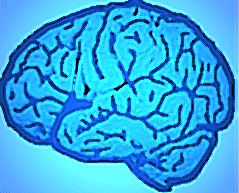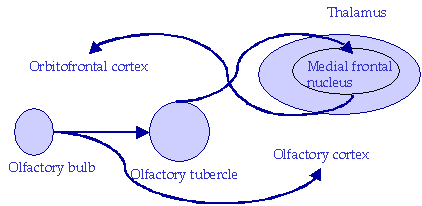
Neuroscience: A Journey Through the Brain
 |
Neuroscience: A Journey Through the Brain |
| Main Page Organization Development Neuron Systems About the site (Glossary) References |
The Major Systems: Sensory Systems - Chemical Senses
|
Sensory System sub categories: Chemical Visual Auditory Somatic |
There are 2 major types of chemical sensations: taste, or gustation, and smell, or olfaction.
Gustation (back to top)
Most neuroscientists now recognize five basic tastes:
saltiness
sourness
sweetness
bitterness
umami (meaning 'delicious'; refers to the taste of the amino acid glutamate, whose common culinary form is MSG)
On the surface of the tongue are small bumps called papillae, which are classified based on their shape:
| Shape | Name |
| Ridge | foliate papillae |
| Pimple | vallate papillae |
| Mushroom | fungiform papillae |
Each papillae has one to several hundred taste buds, which are in turn composed of many taste receptor cells. Taste receptor cells are not neurons, but they form synapses with with the endings of gustatory afferent axons near the bottom of the taste bud. When a taste receptor cell is activated by an appropriate chemical, its membrane potential changes, either hyperpolarizing or depolarizing. Depolarization causes calcium channels to open, allowing calcium to enter the cell and trigger the release of transmitter molecules. This is the basic synaptic transmission between taste receptor cells and sensory neurons. The release of transmitter molecules begins the transduction process to convert chemical information into electrical signals in the brain. The main flow of information is as follows:

The anterior of the tongue sends signals via cranial nerve VII (the facial nerve), the posterior portion of the tongue sends signals via cranial nerve IX (the glossopharyngeal nerve), and the regions around the throat send signals via cranial nerve X (the vagus nerve). In the brainstem, axons synapse on the gustatory nucleus in the medulla. Conscious experience of taste is mediated by the cerebral cortex in the parietal lobe, which receives signals from the ventral posterior nucleus (VPN) of the thalamus. It is in the cortex where the sensation of one or more of the basic tastes is determined.
Olfaction (back to top)
Smell combines with taste to provide information about food, as well as warning of potentially harmful substances or places. Humans can smell several hundred thousand scents, however only about 20% of them are pleasant. Smell can also be a mode of communication - chemicals released from the body called pheromones are important signals for reproductive behaviors, to makr territory, to identify individuals, and to signal aggression or submission.
We do not actually smell with our nose, but rather with a thin sheet of cells high in the nasal cavity called the olfactory epithelium. Unlike the taste receptor cells, the cells that comprise this layer are actual neurons, with their own axons that penetrate the central nervous system.
The olfactory transduction pathway can be described as follows:

The main projection of these cells is to the olfactory bulb. The bulb neurons are very fragile, and damage can result in anosmia, the inability to smell. The input layer of the bulbs contain glomeruli, where the axons of olfactory neurons converge and terminate. The projections in the brain for olfactory information can be illustrated as follows:

Created and Maintained by: Melissa
Davies
Last Updated: April 09, 2002 09:01 PM